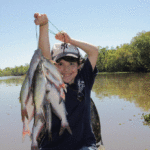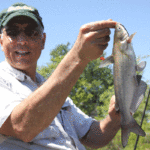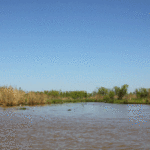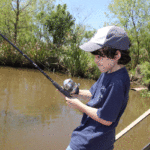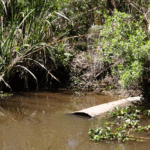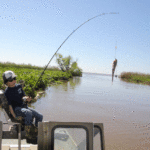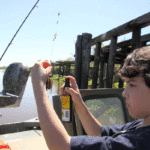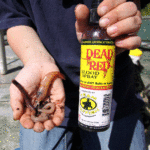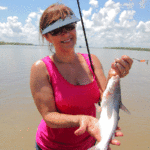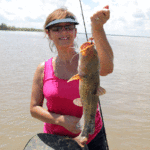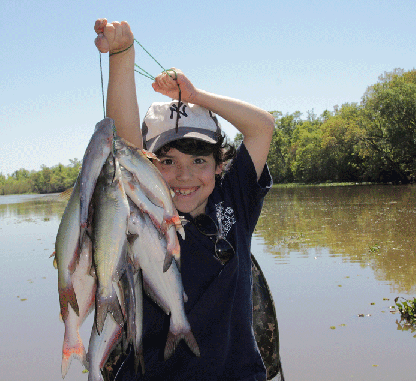
Pack up some night crawlers or river shrimp and head to the coast for some hot catfishing action.
Whether it’s blue catfish or channel catfish, Central Louisiana’s coastal bays in the springtime are teeming with both. Toss in the occasional flathead, and what you have is the skinning pliers Ictalurus Trifecta of North America.
From the Atchafalaya River to East Cote Blanche Bay, nearly every bayou, canal or unnamed tributary that empties freshwater is a potential location to drop anchor and tightline for catfish in this region.
What makes this region so productive is the abundance of food resources catfish have to choose from.
“The mouth of the Atchafalaya River is productive for some of the same reasons that the Atchafalaya River and Atchafalaya Basin are productive,” said Mike Walker, Louisiana Department of Wildlife and Fisheries biologist for the Atchafalaya Basin. “The blue catfish diet is very diverse and the fish can take advantage of the highly productive freshwater and saltwater interface.”
The region is, in short, a smorgasbord.
“The amount of nutrients carried from the rich farmland that the river drains is the foundation for the food web,” Walker said. “Blue catfish take advantage of the availability of estuarine animals that benefit from these nutrients.
“The estuary is populated with organisms like juvenile crabs and shrimp, Gulf menhaden, flatfish like hogchokers, all sorts of minnows, bay anchovies and clams and mussels.”
And, there’s not a better time to do it than spring before the hotter, dog days of summer send coastal cats fleeing for deeper, cooler waters.
It was a few of those potential locations that recently found me and my grandson working on catching enough fish for his grandma to cook us for supper. But the trip was also designed to continue that process of generational bonding and development of a young fisherman.
The trick to the latter part of the process is to fish for something in abundance, where you know you’re going to catch a few fish even on a bad day. What’s more, something that is fairly easy, not too complicated and takes little instruction to be successful is helpful.
Quite frankly, it doesn’t take a lot of skill to catch catfish — where they are present.
It’s the where part that people need to know, and the rest is sort of laissez-faire.
That’a why the coastal outlets are the places to be during the spring.
During a February trip to the marsh fishing for bass, a big 4-pound blue cat put the smackdown on my crankbait.
I noticed its belly seemed extra bloated; just for the sake of curiosity, I decided check out its stomach contents and found it literally packed with shad — proof that these fish have plenty to eat and will gorge themselves seemingly nonstop with such an abundance of food.
What’s interesting is the blue cat was hunting and feeding by sight in attacking the crankbait in moderately clear to slightly stained water. And, though I’ve caught blue cats on spinner baits and beetle spins before, these were all essentially accidents.
No, baits run the gamut dead and alive when it comes to catfish. Moreover, most are designed to appeal to the fish’s olfactory senses. Place a bass or panfish side by side with a catfish, and look at their respective eyes. The beady eyes of a catfish immediately tell you something — you better fish with something that appeals to its sense of smell but is also natural to the estuary.
I kept it pretty basic when fishing with my grandson. We made two stops on the way to the landing. The first stop was to pick up a box of Canadian night crawlers at the local convenience store; the second stop was at Rogers Bartley’s house in Patterson.
Bartley, a commercial cat fisherman who resides on Catherine Street in Patterson, supplies all of the local catfish anglers with fresh river shrimp. I’m undecided which is the better bait when it comes to cat fishing: river shrimp or night crawlers.
Both smell and, therefore, catch equally well. But, maybe the nod goes to the night crawler because they wiggle.
Nonetheless, river shrimp are hard to beat when it comes to catfish.
Bartley runs 35 to 40 homemade shrimp traps each spring along the coastline. On any given day, he’ll pick up approximately 90 to 100 pints of shrimp that he baits his lines with, selling the rest to locals who come calling.
“I was running 60 traps at one time, but it was taking me too long to run shrimp traps and my catfish lines,” Bartley said. “You can catch shrimp all year long, just not as many at certain times.
“In the winter and early spring, I’ll catch 1 to 1 ½ pints of shrimp in each trap. The warmer it gets, I’ll catch 3 or 4 pints.”
The Saturday morning my grandson and I fished happened to fall after several days of heavy rains. My concern was the water would be so dirty it would be like fishing in chocolate milk.
Along the coast, as the marshes drain into the bayous, literally piles of debris, subaquatics and, yes, bait washes into the estuary.
So I decided to drop a little surprise into the tackle box, just to pique a 10-year-old’s interest. Basically, what youngster can resist a “secret weapon” in the form of spray scent attractants? In our case, we used a bottle of Team Catfish’s Dead Red Blood Spray.
Putting in over at Burns Point and making the run around Point Chevreuil to the mouth of Big Beach Bayou, we drowned our first night crawlers and shrimp.
It wasn’t long before the lines went tight, and we caught our first grandpa-and-grandson double when a couple of frying-pansized blue cats ate our scented baits.
Along the brackish-water bays, the salinity level of the water can fluctuate depending on the time of year and weather conditions — particularly rain.
Citing a study conducted by W. Guthrie Perry Jr. on Rockefeller Refuge near Grand Chenier in 1965, Walker said blue cats and channel catfish generally have similar tolerances for salinity but there are striking differences along the Louisiana coast.
“Channel and blue catfish have been found in past studies to have the same tolerance to salinity,” Walker said. “Studies here in Louisiana have found twice as many blue catfish occupy the brackish waters along the coast, as do channel catfish.
“Since the salinity tolerance is close to being the same, there must be a difference in prey preference or habitat preference other than salinity that causes this difference in numbers.”
Perry’s research noted that channel catfish don’t tolerate salinity levels above 1.7 parts per thousand average. And, blue catfish only tolerate slightly more at 3.7 parts per thousand.
Yet, both have been found in water where the salinity levels averaged 11.4 parts per thousand.
However, Perry also noted that, after heavy rains, both species tended to follow the freshwater line as saltwater was pushed back.
When compared to fishing upriver in the Basin, Walker says good catches downriver along the bays basically might be the result of fishing slower, shallower waters and is easier than fishing deeper and swifter water upriver.
Walker, who has done fish sampling all over the Basin and various waterways, said there is a definite deliniation between current preferences between blues and channel cats.
“We have used our electrofishing equipment in the main channel of the Atchafalaya River in late summer to reveal great numbers of blue catfish in that environment,” he explained. “But we tend to find great numbers of channel catfish in the connecting canals and smaller bayous in the fall.”
Ask any commercial fisherman who runs trotlines or spanner lines in the bays in the spring and they’ll all stop when the sharks start running the lines, which in the latter part of May on into June seems to increase as the water warms up.
By then, the fishing often gets better in the main river and in the deeper bayous adjacent to it, where the water is cooler than along the coast.
Keep It Simple, Stupid
Keeping the tackle basic for youngsters is helpful in allowing them to experience success.
On this day, I stuck to a three-way swivel rig. By connecting a 1-ounce pyramid weight to the bottom, a 1/0 bait hook to the side and connecting the top swivel to the main line, I formed an effective setup for catching catfish.
These rigs can be bought ready to go at most department stores and bait shops.
It’s about making it easy. Some anglers tie a staging off the main line and weight the bottom. Basically, it’s the same thing as a ready-made rig, and it works well.
But, basically, it’s about making it easy for youngsters. Tying lots of knots might not be something they can easily do and become frustrated with.
The 1-ounce weight matched the speed of the current at the mouth of Big Beach Bayou.
But in faster currents, heavier may be required; therefore, it’s good to have several weight sizes in your tackle box.
The only coaching I found myself doing was to remind my grandson to reel up the slack in his line from time to time. He got the idea pretty quickly after landing more than his share of catfish.
What’s more, seeing the smile on his face only reaffirmed to me that the basics are beautiful when fishing bay cats with youngsters along this part of the central Louisiana coastline.
Those coming into the area to catfish this part of the state and in need of river shrimp can contact Rogers Bartley by calling (985) 399-8877 or (985) 518-5668.
